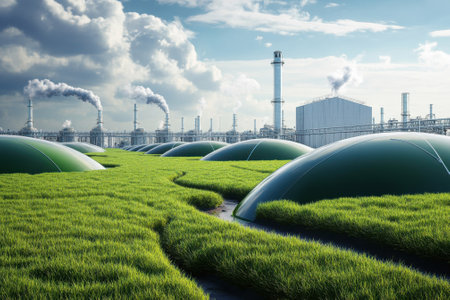Introduction to Energy Flow in Historic Contexts
When wandering through the evocative ruins of Tintagel Castle or strolling along the cobbled streets of York, one may sense more than the mere passing of time. In Britain, historic sites are imbued with a distinctive atmosphere—a palpable energy that seems to linger in the stones, gardens, and landscapes. This phenomenon, often described as energy flow, speaks to both tangible and intangible forces at play within these cherished spaces. In the context of British history and heritage, energy flow encompasses not only the literal movement of people and materials over centuries but also the subtle interplay between memory, culture, and place. As we begin our exploration of this concept, we set out to understand how these currents of energy have shaped, and continue to shape, the spirit and significance of Britains most treasured sites.
2. Iconic Historic Sites and Their Unique Energies
The United Kingdom is home to a myriad of historic sites that have captivated imaginations for centuries, not only because of their architectural grandeur or mysterious origins but also due to the unique energies and atmospheres attributed to them. From ancient stone circles to monumental walls, these locations have become focal points for both scholarly study and popular fascination regarding the concept of energy flow.
Stonehenge: The Ancient Circle of Power
Arguably the most iconic prehistoric monument in Britain, Stonehenge stands on Salisbury Plain as a testament to Neolithic ingenuity and ritual. For generations, visitors and spiritual seekers have claimed to feel a tangible sense of energy within the circle, particularly during solstices. Legends abound, suggesting that Stonehenge was constructed at a point where earth energies converge—sometimes referred to as ley lines—imbuing the stones with a distinct vibrational quality.
Glastonbury Tor: A Mystical Hill in Somerset
Glastonbury Tor rises dramatically above the Somerset Levels, crowned by the solitary tower of St Michael’s Church. It is steeped in Arthurian legend and Christian mythology, reputedly linked to Avalon and the Holy Grail. Many believe that powerful earth energies spiral around the Tor, attracting pilgrims who seek spiritual renewal or enlightenment. The site’s reputation as an energy vortex continues to draw people from across Britain and beyond.
Hadrian’s Wall: The Roman Frontier
Stretching across northern England, Hadrian’s Wall marks the former boundary of the Roman Empire. While its primary purpose was defensive, local folklore holds that the wall channels the energy of past civilisations and echoes with memories of ancient struggles. Some visitors describe a palpable atmosphere along its length—a feeling shaped by both history and landscape.
A Comparison of Site Energies
| Site | Type of Energy or Atmosphere | Associated Traditions & Beliefs |
|---|---|---|
| Stonehenge | Mysterious, powerful; often linked to ley lines | Druid rituals, solstice gatherings, healing energies |
| Glastonbury Tor | Mystical, spiralling; considered an energy vortex | Arthurian legends, Christian pilgrimage, New Age spirituality |
| Hadrian’s Wall | Historic resonance; echoes of ancient conflict | Roman lore, ancestral memory, boundary symbolism |
Tradition Meets Modern Curiosity
The enduring allure of these historic sites lies not only in their storied pasts but also in how they invite contemplation about unseen forces. Whether one approaches them from a scientific perspective or through the lens of folklore, it is clear that Stonehenge, Glastonbury Tor, and Hadrian’s Wall each possess an atmosphere that transcends time—making them uniquely British touchstones for exploring the concept of energy flow.
![]()
3. Cultural Perceptions of Energy and Place
Across the British Isles, the fabric of collective memory is interwoven with stories, beliefs, and customs that attribute a unique energy to historic sites. From ancient stone circles on windswept moors to medieval castles cloaked in mist, these locations are more than architectural relics—they are living embodiments of local folklore and spiritual resonance. The British tradition of storytelling imbues places like Stonehenge, Glastonbury Tor, and Tintagel Castle with a mythic aura, linking them to tales of druids, Arthurian legends, and mystical rituals that speak of unseen currents flowing through the land.
The perception of energy at these sites often transcends the physical, shaped by centuries-old beliefs in ley lines—supposed alignments of ancient monuments and natural features believed to channel earth’s vitality. Such ideas, although not scientifically verified, have become embedded in the cultural consciousness, guiding pilgrimages and inspiring contemplation. Local legends frequently recount encounters with spirits or supernatural phenomena at these landmarks, reinforcing the sense that certain places are imbued with a palpable force that connects past and present.
Spiritual customs also play a significant role in shaping how people experience historic sites in Britain. Seasonal festivals, such as Beltane or Samhain, are still marked at sites like Avebury and the Rollright Stones, where participants seek to attune themselves to the rhythms of nature and ancestral energies. These communal gatherings strengthen bonds within local communities and sustain traditions that honour the land’s mysterious power. In this way, the perceived energy flow at historic landmarks becomes both a personal encounter and a shared cultural inheritance—a testament to how place and memory are inextricably linked in the British imagination.
4. Architectural Design and the Movement of Energy
The relationship between historic sites in the UK and the concept of energy flow is often most strikingly observed through their architectural design. The ancient builders of castles, abbeys, and cathedrals were not only masters of stone and timber but also, perhaps consciously or intuitively, sensitive to the movement of natural energies within the land. From the strategic siting of fortresses atop windswept hills to the careful orientation of abbey naves towards the rising sun, these choices reflect a deep-rooted understanding that the environment can be harnessed to create spaces imbued with both physical and metaphysical vitality.
| Type of Structure | Architectural Feature | Potential Energy Guidance |
|---|---|---|
| Castles | Hilltop Locations, Thick Walls, Circular Towers | Harnessing earth energy for defence and stability; enhancing visibility and command over surrounding land |
| Abbeys & Cathedrals | East-West Orientation, Vaulted Ceilings, Labyrinthine Layouts | Channelling sunlight and spiritual focus; encouraging upward energy movement for contemplation and reverence |
| Stone Circles & Ancient Monuments | Circular Arrangements, Aligned Entrances | Maximising interaction with ley lines; facilitating ritualistic gathering points for communal energy exchange |
It is fascinating to note how many British historic sites incorporate specific geomantic practices—such as dowsing for water or selecting ground believed to possess healing properties—into their foundations. While some may dismiss these decisions as mere superstition or coincidence, others argue that these choices represent an ancient wisdom about harmonising human activity with unseen currents in nature. Whether by design or intuition, the craftsmanship evident in stonework, woodcarving, and spatial arrangement often appears to channel energy in ways that still resonate with visitors today.
5. Modern Interpretations: Science, Spirituality and Tourism
In recent decades, historic sites in the UK have become focal points for a new wave of interpretations concerning the concept of energy flow. These contemporary perspectives draw upon both scientific inquiry and alternative approaches, creating a complex tapestry of meanings that influence how these ancient places are experienced today.
Geophysical Studies and Scientific Insights
Modern science has taken a keen interest in understanding the tangible aspects of historic sites. Geophysical surveys at Stonehenge, Avebury, and other megalithic circles employ advanced technology to reveal underground features and explain how natural energy fields—such as geomagnetism or ley lines—might have influenced ancient builders. While mainstream scientists remain cautious about attributing mystical qualities to these forces, there is an ongoing curiosity about whether early communities were attuned to subtle environmental energies when selecting locations for their monuments.
Alternative Therapies and Spiritual Practices
Alongside scientific investigations, alternative therapies and spiritual practices continue to flourish around Britains historic landmarks. Many believe that sites like Glastonbury Tor or the Rollright Stones possess unique vibrational energies conducive to meditation, healing, or personal transformation. Workshops, guided meditations, and holistic retreats frequently use these locations as backdrops for exploring concepts such as earth energy or chakra alignment, blending ancient folklore with modern wellness trends.
The Influence on Heritage Tourism
This interplay between tradition and modernity has had a pronounced impact on heritage tourism across the UK. Visitors are drawn not only by historical narratives but also by the promise of experiential engagement—be it through dowsing workshops at ancient barrows or solstice celebrations at sacred circles. The commercialisation of energy concepts has led to a burgeoning market for guided tours, souvenirs, and even themed accommodation, all promising access to the hidden power of Britains most storied places.
A Living Dialogue Between Past and Present
Ultimately, these modern interpretations demonstrate how the idea of energy flow at historic sites continues to evolve. Whether approached from a scientific angle or through spiritual exploration, these perspectives invite both locals and tourists to re-imagine their relationship with the landscape—and to see Britain’s heritage not just as static remnants of history, but as dynamic spaces where past wisdom meets contemporary curiosity.
6. Preserving the Past: Conservation and Energy Awareness
The conservation of historic sites across the UK is not merely a matter of mending crumbling stone or restoring faded frescos; it is a nuanced endeavour that weaves together both physical preservation and the safeguarding of intangible qualities, such as energy flow. Increasingly, heritage management professionals are recognising that the essence of a site—its atmosphere, sense of place, and historical resonance—is deeply intertwined with these unseen energies. Efforts to restore castles, abbeys, or ancient standing stones now often include consultations with local communities, historians, and even those sensitive to spatial energy, ensuring that restoration does not inadvertently disrupt the subtle balance that has evolved over centuries.
Modern approaches to conservation in Britain frequently blend traditional craftsmanship with advanced technology, but there is also a growing appreciation for methods that respect the original energy patterns of a site. For example, when repairing medieval cathedrals or stately homes, conservators may choose materials and techniques that align with the building’s original structure, maintaining harmony not only visually but energetically. Furthermore, some projects involve detailed studies into how visitors move through spaces, striving to enhance positive energy flows while preserving the quiet dignity of the past. By acknowledging that historic sites are living entities imbued with stories and emotional resonance, conservationists in the UK are leading the way in a more holistic approach—one that honours both tangible history and the invisible threads of energy that connect past and present.
7. Conclusion: The Enduring Legacy of Energy at Historic Sites
The interplay between history, place, and energy remains a defining characteristic of the British landscape. From the ancient stone circles of Avebury to the storied battlements of Edinburgh Castle, each historic site in the UK is animated not only by its past but by a palpable sense of energy that continues to resonate through time. This dynamic is woven into the fabric of local communities and enriches the experience for visitors from near and far. The flow of energy—be it spiritual, cultural, or environmental—serves as a bridge between generations, enabling stories to be retold and heritage to be reimagined. As we tread these hallowed grounds, we become part of an ongoing narrative where history is not static but alive, its energies shaping our understanding and connection to place. In this way, Britain’s historic sites are more than relics; they are vibrant loci of inspiration, inviting us all to reflect on the enduring power that history and energy hold over our collective imagination.

